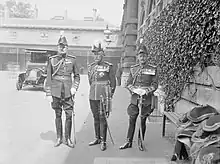Sir George Forestier-Walker | |
|---|---|
| Birth name | George Townshend Forestier Walker |
| Born | 2 August 1866 Camberley, Surrey, England[1] |
| Died | 23 January 1939 (aged 72) Child Okeford, Dorsetshire, England |
| Allegiance | |
| Service/ | |
| Years of service | 1884–1920 |
| Rank | Major-General |
| Unit | Royal Artillery |
| Commands held | 21st Division 27th Division |
| Battles/wars | Second Boer War World War I |
| Awards | Knight Grand Cross of the Order of the Bath |
Major-General Sir George Townshend Forestier-Walker KCB (2 August 1866 – 23 January 1939) was a senior British Army officer during World War I.[2]
Early life and education
Forestier-Walker was born in Camberley, the third son of Major-General George Edmund Lushington Walker and Camilla Georgina Calder, only daughter of Major-General J. Patrick Calder. The grandson of Sir George Townshend Walker, 1st Baronet, he was from an illustrious military family. He was educated at Rugby School and the Royal Military Academy, Woolwich.[3]
Military career

Forestier-Walker was commissioned into the Royal Artillery in 1884[4] and served as Deputy Assistant Adjutant General during the Second Boer War.[5] He became Chief Staff Officer of the Somaliland Field Force in 1902, Assistant Quartermaster General for Intelligence for the Somaliland Field Force in 1903 and saw action again during the East Africa Campaign before becoming Assistant Quartermaster General at Southern Command in 1910.[5] He went on to be brigadier-general on the General Staff of Irish Command in 1912.[5]
Forestier-Walker served in World War I initially as Chief of Staff of II Corps, which went to France with the British Expeditionary Force.[5] He became General Officer Commanding 21st Division in April 1915 and fought at the battle of Loos in September 1915.[5] He went on to command the 63rd (2nd Northumbrian) Division in the Home Forces from February 1916 and to command the 65th (2nd Lowland) Division from September 1916 also in the Home Forces.[6] In December 1916 he became General Officer Commanding 27th Division serving as part of the British Salonika Army and eventually, after the Armistice of Mudros, at Tiflis in Georgia.[7] He retired in 1920 and became Colonel Commandant of the Royal Artillery in 1931.[5][2]
Personal life
In 1892, he married Lady Mary Maud Diana Liddell, daughter of Henry Liddell, 2nd Earl of Ravensworth. They had two sons, both of whom died young, and two daughters:[3]
- Lilian Diana Forestier Walker (12 January 1894 – 5 August 1922)
- George Forestier Walker (born and died 31 May 1898)
- Helen Mary Cecilia Forestier-Walker (17 April 1895 – 28 July 1987)[8]
- Cortlandt Simon Michael Forestier Walker (20 November 1902 – 29 August 1903)
He died at Child Okeford, Blandford, aged 72.
References
- ↑ 1891 England Census
- 1 2 "Obituary: Maj.-General George Forestier Walker – Many Mentions in Despatches". The Times. 24 January 1939.
- 1 2 Mosley, Charles, ed. (2003). Burke's Peerage, Baronetage & Knighthood (107 ed.). Burke's Peerage & Gentry. p. 1467. ISBN 0-9711966-2-1.
- ↑ "No. 25424". The London Gazette. 19 December 1884. p. 5872.
- 1 2 3 4 5 6 George Forestier-Walker
- ↑ Quarterly Army List for the quarter ending 30th June 1919. London: HMSO. 1919. pp. 382.
- ↑ Halpern, Paul (2013). The Mediterranean Fleet, 1919–1929. Ashgate Publishing, Ltd. p. 21. ISBN 978-1409482802.
- ↑ "Deaths". The Times. 29 July 1987. p. 1.